List of Charadriiformes by population
| The population of birds |
|---|
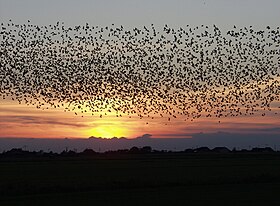 |
This is a list of Charadriiformes species by global population. While numbers are estimates, they have been made by the experts in their fields.
Charadriiformes (Charadrius being Latin for "plover") is the taxonomic order to which the waders, gulls, and auks belong. BirdLife International has assessed 352 species; 181 (51% of total species) have had their population estimated. Bird taxonomy is currently in a state of flux, much wider in scope than the complications arising from the realization that birds are dinosaurs, and a full scientific consensus on the division of orders has yet to be settled upon.[1] The Charadriiformes, for example, are grouped with the Ciconiiformes in the Sibley-Ahlquist taxonomy.[2] In the interest of standardization this article, along with the rest of the Wikipedia Bird Population lists, is split along the taxonomic system used by BirdLife, which is both the Earth's largest partnership of conservation organizations, and the assessment team for birds on the IUCN Red List.[3][4] This is not an endorsement of any one taxonomic system, and it may change in the future as new relationships are brought to light.
A variety of methods are used for counting Charadriiformes. For example, the piping plover is subject to the quinquennial Piping Plover International Census, which is carried out in 9 Canadian provinces, 32 US states, Mexico, Central America, and the Caribbean. In the 2006 survey, Saskatchewan alone had 159 volunteers scour 294 waterbodies.[5][6] The mountain plover has had its nests counted through the drive transect method. Once density has been calculated, the numbers are extrapolated over a bird's range.[7] For more information on how these estimates were ascertained, see Wikipedia's articles on population biology and population ecology.
Species which can no longer be included in a list of this nature include the Tahiti sandpiper, which was only recorded in 1777, and is suspected to have fallen prey to introduced egg-eating rats.[8] The same fate awaited the white-winged sandpiper.[9] The Canarian oystercatcher was reported vanished by 1940, believed to have been the result of overfishing of its sustenance.[10] The feathers of the great auk made excellent pillows, and egg collectors were so successful in their hobby that the last specimen in Britain was seen in 1840 on Stac an Armin, Scotland. This was beaten to death by three men believing it to be a witch.[11][12]
The continued existence of some species has yet to be confirmed either way. The Javan lapwing, for example, has not had a confirmed sighting since 1940, but unconfirmed reports continue to give hope that the last individual has yet to die.[13] The last confirmed sightings of the Eskimo curlew were in the early 1980s, but scientists would rather not issue a former declaration of extinction until surveying of all potential breeding locations is completed.[14] The slender-billed curlew (included in the list below) was considered "very common" in the early 1800s, rare by the early 1900s. The bird was recorded 103 times between 1980 and 1990, and 74 times between 1990 and 1999. The last confirmed recording of the slender-billed curlew was in April 2001.[15]
Critically Endangered means a species has experienced a decline of at least 80% in the past ten years or three generations, or is projected to decline that much over the same period of time.[16] A species's continued existence does not necessarily mean the bird can be salvaged, as it may have already passed the minimum viable population.
Species by global population
| Common name | Binomial name | Population | Status | Trend | Notes | Image |
|---|---|---|---|---|---|---|
| Black stilt | Himantopus novaezelandiae | 40[17] | CR[17] | 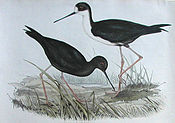
| ||
| Chinese crested tern | Sterna bernsteini | 50[18] | CR[18] | Maximum estimate.[18] | ||
| Slender-billed curlew | Numenius tenuirostris | 50[15] | CR[15] | 
| ||
| Jerdon's courser | Rhinoptilus bitorquatus | 70 – 400[19] | CR[19] | 
| ||
| Saint Helena plover | Charadrius sanctaehelenae | 70 – 400[20] | CR[20] | 
| ||
| Shore dotterel | Thinornis novaeseelandiae | 250[21] | EN[21] | 
| ||
| Chatham oystercatcher | Haematopus chathamensis | 310 – 360[22] | EN[22] | |||
| Spoon-billed sandpiper | Eurynorhynchus pygmeus | 360 – 600[23] | CR[23] | Estimate is considered "optimistic".[23] | 
| |
| Nordmann's greenshank | Tringa guttifer | 500 – 1000[24] | EN[24] | "Optimistic."[24] | 
| |
| Peruvian tern | Sterna lorata | 600 – 1700[25] | EN[25] | |||
| Lava gull | Larus fuliginosus | 900 – 1200[26] | VU[26] | Possibly overestimated.[26] | 
| |
| Australian painted-snipe | Rostratula australis | 1000 – 1500[27] | EN[27] | 
| ||
| Andean lapwing | Vanellus resplendens | 1000 – 10 000[28] | LC[28] | 
| ||
| Belcher's gull | Larus belcheri | 1000 – 10 000[29] | LC[29] | 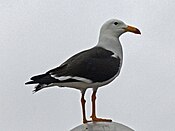
| ||
| Collared plover | Charadrius collaris | 1000 – 10 000[30] | LC[30] | 
| ||
| Madagascar jacana | Actophilornis albinucha | 1000 – 10 000[31] | NT[31] | |||
| Snowy-crowned tern | Sterna trudeaui | 1000 – 10 000[32] | LC[32] | 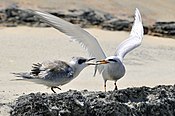
| ||
| Spot-breasted lapwing | Vanellus melanocephalus | 1000 – 10 000[33] | LC[33] | Unknown[33] | 
| |
| Tawny-throated dotterel | Oreopholus ruficollis | 1000 – 10 000[34] | LC[34] | 
| ||
| Tuamotu sandpiper | Prosobonia cancellata | 1300[35] | EN[35] | Minimum estimate.[35] | 
| |
| Hawaiian stilt | Himantopus knudnesi | 1350 | EN | May be subspecies of black-necked stilt or black-winged stilt. | 
| |
| New Zealand plover | Charadrius obscurus | 2000[36] | EN[36] | Divided into two subspecies: C. obscurus obscurus (~1701 individuals) & C. obscurus aquilonius (~270 individuals).[36] | 
| |
| Large-billed tern | Phaetusa simplex | 2000 – 7000[37] | LC[37] | 
| ||
| Plains-wanderer | Pedionomus torquatus | 2000 – 7000[38] | EN[38] | |||
| Diademed plover | Phegornis mitchellii | 2500 – 9999[39] | NT[39] | 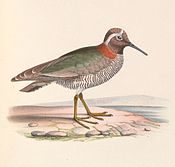
| ||
| Fuegian snipe | Gallinago stricklandii | 2500 – 9999[40] | NT[40] | 
| ||
| Magellanic plover | Pluvianellus socialis | 2500 – 9999[41] | NT[41] | 
| ||
| Chatham snipe | Coenocorypha pusilla | 2700 – 3300[42] | VU[42] | 
| ||
| Madagascar plover | Charadrius thoracicus | 2700 – 3500[43] | VU[43] | |||
| Kerguelen tern | Sterna virgata | 3500 – 6500[44] | NT[44] | 
| ||
| Amami woodcock | Scolopax mira | 3500 – 15 000[45] | VU[45] | |||
| Japanese murrelet | Synthliboramphus wumizusume | 3500 – 15 000[46] | VU[46] | 
| ||
| Madagascar snipe | Gallinago macrodactyla | 3500 – 15 000[47] | VU[47] | |||
| Moluccan woodcock | Scolopax rochussenii | 3500 – 15 000[48] | EN[48] | |||
| Wood snipe | Gallinago nemoricola | 3500 – 15 000[49] | VU[49] | 
| ||
| Wrybill | Anarhynchus frontalis | 4500 – 5000[50] | VU[50] | 
| ||
| African oystercatcher | Haematopus moquini | 5000 – 6000[51] | NT[51] | 
| ||
| Madagascar pratincole | Glareola ocularis | 5000 – 10 000[52] | VU[52] | 
| ||
| Yellow-wattled lapwing | Vanellus malarbaricus | 5000 – 10 000[53] | VU[53] | 
| ||
| Beach stone-curlew | Esacus giganteus | 6000[54] | NT[54] | 
| ||
| Indian skimmer | Rynchops albicollis | 6000 – 10 000[55] | VU[55] | 
| ||
| Black-fronted tern | Sterna albostriata | 7000 – 10 000[56] | EN[56] | 
| ||
| Black oystercatcher | Haematopus bachmani | 8900 – 11 000[57] | LC[57] | 
| ||
| Craveri's murrelet | Synthliboramphus craveri | 9000 – 15 000[58] | VU[58] | |||
| Bristle-thighed curlew | Numenius tahitiensis | 10 000[59] | VU[59] | 
| ||
| Imperial snipe | Gallinago imperialis | 10 000[60] | NT[60] | Preliminary minimum estimate.[60] | 
| |
| Hooded plover | Thinornis rubricollis | 10 000 – 11 000[61] | VU[61] | 
| ||
| Brown skua | Stercorarius lonnbergi | 10 000 – 19 999[62] | LC[62] | 
| ||
| Guadalupe murrelet | Synthliboramphus hypoleucus | 10 000 – 19 999[63] | VU[63] | |||
| South polar skua | Stercorarius maccormicki | 10 000 – 19 999[64] | LC[64] | 
| ||
| Black-bellied tern | Sterna acuticauda | 10 000 – 25 000[65] | EN[65] | 
| ||
| Grey-breasted seedsnipe | Thinocorus orbignyianus | 10 000 – 25 000[66] | LC[66] | |||
| Malaysian plover | Charadrius peronii | 10 000 – 25 000[67] | NT[67] | "Probable."[67] | 
| |
| Wandering tattler | Heteroscelus incanus | 10 000 – 25 000[68] | LC[68] | 
| ||
| Dolphin gull | Leucophaeus scoresbii | 10 000 – 28 000[69] | LC[69] | 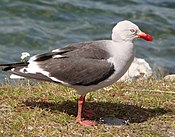
| ||
| Olrog's gull | Larus atlanticus | 10 500[70] | VU[70] | 
| ||
| Grey pratincole | Glareola cinerea | 11 000 – 35 000[71] | LC[71] | Unknown[71] | ||
| Solitary snipe | Gallinago solitaria | 11 000 – 110 000[72] | LC[72] | |||
| Piping plover | Charadrius melodus | 12 000 – 13 000[73] | NT[73] | 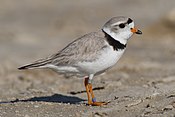
| ||
| Black-faced sheathbill | Chionis minor | 13 000 – 20 000[74] | LC[74] | 
| ||
| Mountain plover | Charadrius montanus | 15 000 – 20 000[75] | NT[75] | 
| ||
| African skimmer | Rynchops flavirostris | 15 000 – 25 000[76] | NT[76] | 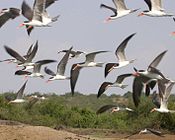
| ||
| Relict gull | Larus relictus | 15 000 – 30 000[77] | VU[77] | |||
| Sociable lapwing | Vanellus gregarius | 16 000 – 17 000[78] | CR[78] | 
| ||
| Little auk | Alle alle | 16 000 – 36 000[79] | LC[79] | 
| ||
| Buff-breasted sandpiper | Tryngites subruficollis | 16 000 – 84 000[80] | NT[80] | 
| ||
| Chestnut-banded plover | Charadrius pallidus | 16 200 – 17 500[81] | NT[81] | 
| ||
| Ivory gull | Pagophila eburnea | 19 000 – 27 000[82] | NT[82] | 
| ||
| Kittlitz's murrelet | Brachyramphus brevirostris | 20 000 – 40 000[83] | CR[83] | 
| ||
| Saunders's gull | Larus saundersi | 21 000 – 22 000[84] | VU[84] | 
| ||
| Asian dowitcher | Limnodromus semipalmatus | 23 000[85] | NT[85] | 
| ||
| Long-toed stint | Calidris subminuta | 25 000[86] | LC[86] | Unknown[86] | Minimum estimate.[86] | 
|
| Grey-headed lapwing | Vanellus cinereus | 25 000 – 100 000[87] | LC[87] | 
| ||
| Latham's snipe | Gallinago hardwickii | 25 000 – 100 000[88] | LC[88] | 
| ||
| Pectoral sandpiper | Calidris melanotos | 25 000 – 100 000[89] | LC[89] | 
| ||
| Ross's gull | Rhodostethia rosea | 25 000 – 100 000[90] | LC[90] | Unknown[90] | 
| |
| Swinhoe's snipe | Gallinago megala | 25 000 – 100 000[91] | LC[91] | Unknown[91] | ||
| Blue noddy | Procelsterna cerulea | 27 000 – 120 000[92] | LC[92] | 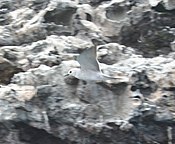
| ||
| Aleutian tern | Sterna aleutica | 30 000 – 35 000[93] | LC[93] | |||
| White-eyed gull | Larus leucophthalmus | 37 000 – 44 000[94] | NT[94] | 
| ||
| Eastern curlew | Numenius madagascariensis | 38 000[95] | VU[95] | 
| ||
| Grey-tailed tattler | Heteroscelus brevipes | 40 000[96] | LC[96] | Minimum estimate.[96] | 
| |
| Great skua | Stercorarius skua | 48 000[97] | LC[97] | 
| ||
| Damara tern | Sterna balaenarum | 50 000 – 100 000[98] | NT[98] | |||
| River tern | Sterna aurantia | 50 000 – 100 000[99] | NT[99] | 
| ||
| Long-billed curlew | Numenius americanus | 50 000 – 123 000[100] | LC[100] | 
| ||
| Eurasian dotterel | Eudromias morinellus | 50 000 – 220 000[101] | LC[101] | 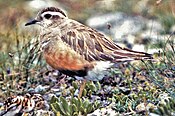
| ||
| Audouin's gull | Larus audouinii | 63 900 – 66 900[102] | NT[102] | 
| ||
| Roseate tern | Sterna dougallii | 70 000 – 82 000[103] | LC[103] | Unknown[103] | 
| |
| Broad-billed sandpiper | Limicola falcinellus | 71 000 – 160 000[104] | LC[104] | 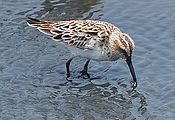
| ||
| Little gull | Larus minutus | 97 000 – 270 000[105] | LC[105] | 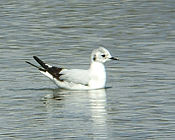
| ||
| Whiskered auklet | Aethia pygmaea | 100 000[106] | LC[106] | 
| ||
| Pheasant-tailed jacana | Hydrophasianus chirurgus | 100 000[107] | LC[107] | Minimum estimate.[107] | 
| |
| Spotted redshank | Tringa erythropus | 110 000 – 350 000[108] | LC[108] | 
| ||
| Spectacled guillemot | Cepphus carbo | 140 000 – 148 000[109] | LC[109] | 
| ||
| Eurasian stone-curlew | Burhinus oedicnemus | 140 000 – 330 000[110] | LC[110] | 
| ||
| Inca tern | Larosterna inca | 150 000[111] | NT[111] | Minimum estimate.[111] | 
| |
| Semipalmated plover | Charadrius semipalmatus | 150 000[112] | LC[112] | Minimum estimate.[112] | 
| |
| Gull-billed tern | Sterna nilotica | 150 000 – 420 000[113] | LC[113] | 
| ||
| Greater crested tern | Sterna bergii | 150 000 – 1 100 000[114] | LC[114] | 
| ||
| Oriental plover | Charadrius veredus | 160 000[115] | LC[115] | Unknown[115] | ||
| Sharp-tailed sandpiper | Calidris acuminata | 160 000[116] | LC[116] | Minimum estimate.[116] | 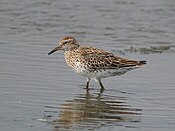
| |
| Rock sandpiper | Calidris ptilocnemis | 160 000 – 170 000[117] | LC[117] | 
| ||
| Terek sandpiper | Xenus cinereus | 160 000 – 1 200 000[118] | LC[118] | 
| ||
| Temminck's stint | Calidris temminckii | 170 000 – 1 300 000[119] | LC[119] | Unknown[119] | 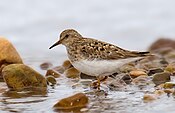
| |
| Little curlew | Numenius minutus | 180 000[120] | LC[120] | Minimum estimate.[120] | 
| |
| Greater sand plover | Charadrius leschenaultii | 180 000 – 360 000[121] | LC[121] | Unknown[121] | 
| |
| Brown noddy | Anous stolidus | 180 000 – 1 100 000[122] | LC[122] | 
| ||
| Pacific golden plover | Pluvialis fulva | 190 000 – 250 000[123] | LC[123] | 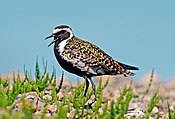
| ||
| Little tern | Sterna albifrons | 190 000 – 410 000[124] | LC[124] | 
| ||
| American golden plover | Pluvialis dominica | 200 000[125] | LC[125] | Minimum estimate.[125] | 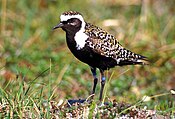
| |
| Pied avocet | Recurvirostra avosetta | 210 000 – 460 000[126] | LC[126] | Unknown[126] | 
| |
| Black-winged pratincole | Glareola nordmanni | 220 000- 290 000[127] | NT[127] | 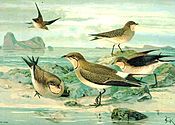
| ||
| Caspian tern | Sterna caspia | 240 000 – 420 000[128] | LC[128] | 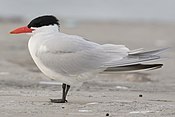
| ||
| Marsh sandpiper | Tringa stagnatilis | 260 000 – 1 200 000[129] | LC[129] | 
| ||
| Little ringed plover | Charadrius dubius | 280 000 – 530 000[130] | LC[130] | 
| ||
| Baird's sandpiper | Calidris bairdii | 300 000[131] | LC[131] | Minimum estimate.[131] | 
| |
| Kentish plover | Charadrius alexandrinus | 300 000 – 460 000[132] | LC[132] | 
| ||
| Whiskered tern | Chlidonias hybrida | 300 000 – 1 500 000[133] | LC[133] | 
| ||
| Lesser sand plover | Charadrius mongolus | 310 000 – 390 000[134] | LC[134] | Unknown[134] | 
| |
| Red-necked stint | Calidris ruficollis | 320 000[135] | LC[135] | Unknown[135] | Minimum estimate.[135] | 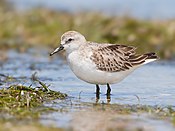
|
| Sabine's gull | Xema sabini | 330 000 – 700 000[136] | LC[136] | 
| ||
| Red-legged kittiwake | Rissa brevirostris | 337 000 – 377 000[137] | VU[137] | 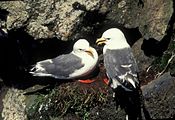
| ||
| Glaucous gull | Larus hyperboreus | 340 000 – 2 400 000[138] | LC[138] | 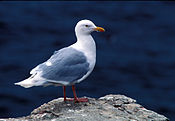
| ||
| Marbled murrelet | Brachyramphus marmoratus | 350 000 – 420 000[139] | EN[139] | 
| ||
| Common ringed plover | Charadrius hiaticula | 360 000 – 1 300 000[140] | LC[140] | 
| ||
| Great knot | Calidris tenuirostris | 380 000[141] | VU[141] | 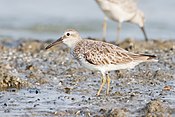
| ||
| Long-billed dowitcher | Limnodromus scolopaceus | 400 000[142] | LC[142] | Unknown[142] | Minimum estimate.[142] | 
|
| Common greenshank | Tringa nebularia | 440 000 – 1 500 000[143] | LC[143] | 
| ||
| Black guillemot | Cepphus grylle | 400 000 – 700 000[144] | LC[144] | 
| ||
| Black-winged stilt | Himantopus himantopus | 450 000 – 780 000[145] | LC[145] | 
| ||
| Ruddy turnstone | Arenaria interpres | 460 000 – 800 000[146] | LC[146] | 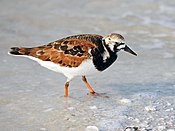
| ||
| Pigeon guillemot | Cepphus columba | 470 000[147] | LC[147] | Minimum estimate.[147] | 
| |
| Double-striped thick-knee | Burhinus bistriatus | 500 000 – 4 999 999[148] | LC[148] | 
| ||
| Northern jacana | Jacana spinosa | 500 000 – 4 999 999[149] | LC[149] | Unknown[149] | 
| |
| Glaucous-winged gull | Larus glaucescens | 570 000[150] | LC[150] | Minimum estimate.[150] | 
| |
| Bridled tern | Sterna anaethetus | 610 000 – 1 500 000[151] | LC[151] | Unknown[151] | 
| |
| Sanderling | Calidris alba | 620 000 – 700 000[152] | LC[152] | Unknown[152] | 
| |
| Grey plover | Pluvialis squatarola | 692 000[153] | LC[153] | 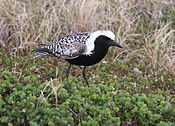
| ||
| Common redshank | Tringa totanus | 960 000 – 2 600 000[154] | LC[154] | Unknown[154] | 
| |
| African jacana | Actophilornis africanus | 1 000 000[155] | LC[155] | 
| ||
| Killdeer | Charadrius vociferus | 1 000 000[156] | LC[156] | 
| ||
| Jack snipe | Lymnocryptes minimus | 1 000 000[157] | LC[157] | Minimum estimate.[157] | 
| |
| Ancient murrelet | Synthliboramphus antiquus | 1 000 000 – 2 000 000[158] | LC[158] | 
| ||
| Whimbrel | Numenius phaeopus | 1 000 000 – 2 300 000[159] | LC[159] | 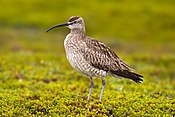
| ||
| Black-tailed gull | Larus crassirostris | 1 100 000[160] | LC[160] | Minimum estimate.[160] | 
| |
| Red knot | Calidris canutus | 1 100 000[161] | LC[161] | Minimum estimate.[161] | 
| |
| Bar-tailed godwit | Limosa lapponica | 1 100 000 – 1 200 000[162] | LC[162] | 
| ||
| Eurasian oystercatcher | Haematopus ostralegus | 1 100 000 – 1 200 000[163] | LC[163] | 
| ||
| Red phalarope | Phalaropus fulicarius | 1 100 000 – 2 000 000[164] | LC[164] | 
| ||
| Horned puffin | Fratercula corniculata | 1 200 000[165] | LC[165] | Minimum estimate.[165] | 
| |
| Lesser noddy | Anous tenuirostris | 1 200 000[166] | LC[166] | Minimum estimate.[166] | 
| |
| Parakeet auklet | Aethia psittacula | 1 200 000[167] | LC[167] | Minimum estimate.[167] | 
| |
| Green sandpiper | Tringa ochropus | 1 200 000 – 3 600 000[168] | LC[168] | 
| ||
| Rhinoceros auklet | Cerorhinca monocerata | 1 300 000[169] | LC[169] | Minimum estimate.[169] | 
| |
| Little stint | Calidris minuta | 1 400 000 – 1 500 000[170] | LC[170] | 
| ||
| Common tern | Sterna hirundo | 1 600 000 – 4 600 000[171] | LC[171] | 
| ||
| Curlew sandpiper | Calidris ferruginea | 1 800 000 – 1 900 000[172] | LC[172] | 
| ||
| Arctic tern | Sterna paradisaea | 2 000 000[173] | LC[173] | Minimum estimate.[173] | 
| |
| Southern lapwing | Vanellus chilensis | 2 000 000[174] | LC[174] | 
| ||
| Ruff | Philomachus pugnax | 2 000 000 – 2 600 000[175] | LC[175] | 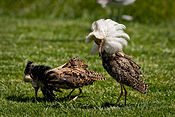
| ||
| Semipalmated sandpiper | Calidris pusilla | 2 200 000[176] | NT[176] | 
| ||
| Common gull | Larus canus | 2 500 000 – 3 700 000[177] | LC[177] | Unknown[177] | 
| |
| White-winged tern | Chlidonias leucopterus | 2 500 000 – 4 500 000[178] | LC[178] | 
| ||
| Common sandpiper | Actitis hypoleucos | 2 600 000 – 3 200 000[179] | LC[179] | 
| ||
| European herring gull | Larus argentatus | 2 700 000 – 5 700 000[180] | LC[180] | Unknown[180] | 
| |
| Oriental pratincole | Glareola maldivarum | 2 900 000 – 3 000 000[181] | LC[181] | 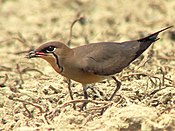
| ||
| Wood sandpiper | Tringa glareola | 3 100 000 – 3 600 000[182] | LC[182] | 
| ||
| Kelp gull | Larus dominicanus | 3 300 000 – 4 300 000[183] | LC[183] | 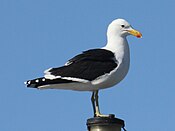
| ||
| Tufted puffin | Fratercula cirrhata | 3 500 000[184] | LC[184] | Minimum estimate.[184] | 
| |
| Red-necked phalarope | Phalaropus lobatus | 3 600 000 – 4 500 000[185] | LC[185] | 
| ||
| Dunlin | Calidris alpina | 4 600 000 – 6 500 000[186] | LC[186] | 
| ||
| Black-headed gull | Larus ridibundus | 4 800 000 – 8 900 000[187] | LC[187] | 
| ||
| Northern lapwing | Vanellus vanellus | 5 200 000 – 10 000 000[188] | LC[188] | 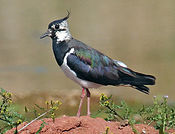
| ||
| Common snipe | Gallinago gallinago | 6 300 000 – 8 100 000[189] | LC[189] | 
| ||
| Crested auklet | Aethia cristatella | 8 200 000[190] | LC[190] | Minimum estimate.[190] | 
| |
| Eurasian woodcock | Scolopax rusticola | 10 000 000 – 26 000 000[191] | LC[191] | 
| ||
| Black-legged kittiwake | Rissa tridactyla | 17 000 000 – 18 000 000[192] | LC[192] | 
| ||
| Common murre | Uria aalge | 18 000 000[193] | LC[193] | Minimum estimate.[193] | 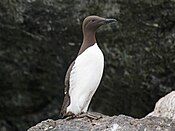
| |
| Sooty tern | Sterna fuscata | 21 000 000 – 22 000 000[194] | LC[194] | Unknown[194] | 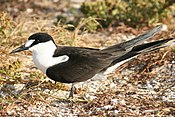
| |
| Thick-billed murre | Uria lomvia | 22 000 000[195] | LC[195] | Minimum estimate.[195] | 
| |
| Least auklet | Aethia psittacula | 24 000 000[196] | LC[196] | Minimum estimate.[167] | 
|
See also
References
- ^ Boyd, John H. (25 November 2008). "Aves—A Taxonomy in Flux 2.11 : Modern Birds". Florida International University. Retrieved 2012-12-24.
- ^ "Sibley's Sequence : Based on DNA hybridization comparisons by Charles Gald Sibley - Burt L. Monroe, Jr". Retrieved 2012-12-24.
- ^ "About BirdLife". BirdLife International. 2012. Retrieved 2012-12-24.
- ^ "Birds on the IUCN Red List". BirdLife International. 2012. Retrieved 2012-12-24.
- ^ Forest and Rangeland Ecosystem Science Center. "2011 International Piping Plover Census: Study Description". United States Geological Survey. Retrieved 2012-12-24.
- ^ "Positive Piping Plover Count". Government of Saskatchewan. 6 Nov 2006. Archived from the original on 2013-05-06. Retrieved 2012-12-24.
- ^ "Mountain plover survey guidelines - Wyoming" (PDF). United States Fish and Wildlife Service. March 2002. Archived from the original (PDF) on 2013-06-02. Retrieved 2012-12-24.
- ^ BirdLife International (2012). "Prosobonia leucoptera". IUCN Red List of Threatened Species. Version 2012.2. IUCN. Retrieved 2012-12-23.
- ^ BirdLife International (2012). "Prosobonia ellisi". IUCN Red List of Threatened Species. Version 2012.2. IUCN. Retrieved 2012-12-23.
- ^ BirdLife International (2012). "Haematopus meadewaldoi". IUCN Red List of Threatened Species. Version 2012.2. IUCN. Retrieved 2012-12-23.
- ^ Gaskell, Jeremy (2000). Who Killed the Great Auk?. Oxford UP. p. 142. ISBN 978-0-19-856478-2.
- ^ BirdLife International (2012). "Pinguinus impennis". IUCN Red List of Threatened Species. Version 2012.2. IUCN. Retrieved 2012-12-23.
- ^ BirdLife International (2012). "Vanellus macropterus". IUCN Red List of Threatened Species. Version 2012.2. IUCN. Retrieved 2012-12-23.
- ^ BirdLife International (2012). "Numenius borealis". IUCN Red List of Threatened Species. Version 2012.2. IUCN. Retrieved 2012-12-23.
- ^ a b c d BirdLife International (2012). "Numenius tenuirostris". IUCN Red List of Threatened Species. Version 2012.2. IUCN. Archived from the original on 2012-11-12. Retrieved 2012-12-23.
- ^ IUCN (2001). "V. THE CRITERIA FOR CRITICALLY ENDANGERED, ENDANGERED AND VULNERABLE". Retrieved 2012-12-23.
- ^ a b c BirdLife International (2012). "Himantopus novaezelandiae". IUCN Red List of Threatened Species. Version 2012.2. IUCN. Archived from the original on 2012-11-12. Retrieved 2012-12-06.
- ^ a b c d BirdLife International (2012). "Sterna bernsteini". IUCN Red List of Threatened Species. Version 2012.2. IUCN. Retrieved 2012-12-09.
- ^ a b c BirdLife International (2012). "Rhinoptilus bitorquatus". IUCN Red List of Threatened Species. Version 2012.2. IUCN. Retrieved 2012-12-06.
- ^ a b c BirdLife International (2012). "Charadrius sanctaehelenae". IUCN Red List of Threatened Species. Version 2012.2. IUCN. Retrieved 2012-12-05.
- ^ a b c BirdLife International (2012). "Thinornis novaeseelandiae". IUCN Red List of Threatened Species. Version 2012.2. IUCN. Archived from the original on 2013-09-27. Retrieved 2012-12-09.
- ^ a b c BirdLife International (2012). "Haematopus chathamensis". IUCN Red List of Threatened Species. Version 2012.2. IUCN. Retrieved 2012-12-06.
- ^ a b c d BirdLife International (2012). "Eurynorhynchus pygmeus". IUCN Red List of Threatened Species. Version 2012.2. IUCN. Retrieved 2012-12-06.
- ^ a b c d BirdLife International (2012). "Tringa guttifer". IUCN Red List of Threatened Species. Version 2012.2. IUCN. Archived from the original on 2013-09-27. Retrieved 2012-12-09.
- ^ a b c BirdLife International (2012). "Sterna lorata". IUCN Red List of Threatened Species. Version 2012.2. IUCN. Retrieved 2012-12-09.
- ^ a b c d BirdLife International (2012). "Larus fuliginosus". IUCN Red List of Threatened Species. Version 2012.2. IUCN. Retrieved 2012-12-06.
- ^ a b c BirdLife International (2012). "Rostratula australis". IUCN Red List of Threatened Species. Version 2012.2. IUCN. Retrieved 2012-12-06.
- ^ a b c BirdLife International (2012). "Vanellus resplendens". IUCN Red List of Threatened Species. Version 2012.2. IUCN. Retrieved 2012-12-09.
- ^ a b c BirdLife International (2012). "Larus belcheri". IUCN Red List of Threatened Species. Version 2012.2. IUCN. Retrieved 2012-12-06.
- ^ a b c BirdLife International (2012). "Charadrius collaris". IUCN Red List of Threatened Species. Version 2012.2. IUCN. Retrieved 2012-12-05.
- ^ a b c BirdLife International (2012). "Actophilornis albinucha". IUCN Red List of Threatened Species. Version 2012.2. IUCN. Retrieved 2012-12-05.
- ^ a b c BirdLife International (2012). "Sterna trudeaui". IUCN Red List of Threatened Species. Version 2012.2. IUCN. Retrieved 2012-12-09.
- ^ a b c BirdLife International (2012). "Vanellus melanocephalus". IUCN Red List of Threatened Species. Version 2012.2. IUCN. Retrieved 2012-12-09.
- ^ a b c BirdLife International (2012). "Oreopholus ruficollis". IUCN Red List of Threatened Species. Version 2012.2. IUCN. Retrieved 2012-12-06.
- ^ a b c d BirdLife International (2012). "Prosobonia cancellata". IUCN Red List of Threatened Species. Version 2012.2. IUCN. Retrieved 2012-12-06.
- ^ a b c d BirdLife International (2012). "Charadrius obscurus". IUCN Red List of Threatened Species. Version 2012.2. IUCN. Retrieved 2012-12-05.
- ^ a b c BirdLife International (2012). "Phaetusa simplex". IUCN Red List of Threatened Species. Version 2012.2. IUCN. Retrieved 2012-12-06.
- ^ a b c BirdLife International (2012). "Pedionomus torquatus". IUCN Red List of Threatened Species. Version 2012.2. IUCN. Retrieved 2012-12-06.
- ^ a b c BirdLife International (2012). "Phegornis mitchellii". IUCN Red List of Threatened Species. Version 2012.2. IUCN. Retrieved 2012-12-06.
- ^ a b c BirdLife International (2012). "Gallinago stricklandii". IUCN Red List of Threatened Species. Version 2012.2. IUCN. Retrieved 2012-12-06.
- ^ a b c BirdLife International (2012). "Coenocorypha pusilla". IUCN Red List of Threatened Species. Version 2012.2. IUCN. Retrieved 2012-12-06.
- ^ a b c BirdLife International (2012). "Charadrius thoracicus". IUCN Red List of Threatened Species. Version 2012.2. IUCN. Retrieved 2012-12-05.
- ^ a b c BirdLife International (2012). "Sterna virgata". IUCN Red List of Threatened Species. Version 2012.2. IUCN. Retrieved 2012-12-09.
- ^ a b c BirdLife International (2012). "Scolopax mira". IUCN Red List of Threatened Species. Version 2012.2. IUCN. Retrieved 2012-12-09.
- ^ a b c BirdLife International (2012). "Synthliboramphus wumizusume". IUCN Red List of Threatened Species. Version 2012.2. IUCN. Retrieved 2012-12-09.
- ^ a b c BirdLife International (2012). "Gallinago macrodactyla". IUCN Red List of Threatened Species. Version 2012.2. IUCN. Retrieved 2012-12-06.
- ^ a b c BirdLife International (2012). "Scolopax rochussenii". IUCN Red List of Threatened Species. Version 2012.2. IUCN. Retrieved 2012-12-09.
- ^ a b c BirdLife International (2012). "Gallinago nemoricola". IUCN Red List of Threatened Species. Version 2012.2. IUCN. Retrieved 2012-12-06.
- ^ a b c BirdLife International (2012). "Anarhynchus frontalis". IUCN Red List of Threatened Species. Version 2012.2. IUCN. Archived from the original on 2013-09-27. Retrieved 2012-12-05.
- ^ a b c BirdLife International (2012). "Haematopus moquini". IUCN Red List of Threatened Species. Version 2012.2. IUCN. Retrieved 2012-12-06.
- ^ a b c BirdLife International (2012). "Glareola ocularis". IUCN Red List of Threatened Species. Version 2012.2. IUCN. Retrieved 2012-12-06.
- ^ a b c BirdLife International (2012). "Vanellus malarbaricus". IUCN Red List of Threatened Species. Version 2012.2. IUCN. Retrieved 2012-12-09.
- ^ a b c BirdLife International (2012). "Esacus giganteus". IUCN Red List of Threatened Species. Version 2012.2. IUCN. Retrieved 2012-12-06.
- ^ a b c BirdLife International (2012). "Rynchops albicollis". IUCN Red List of Threatened Species. Version 2012.2. IUCN. Retrieved 2012-12-06.
- ^ a b c BirdLife International (2012). "Sterna albostriata". IUCN Red List of Threatened Species. Version 2012.2. IUCN. Retrieved 2012-12-09.
- ^ a b c BirdLife International (2012). "Haematopus bachmani". IUCN Red List of Threatened Species. Version 2012.2. IUCN. Retrieved 2012-12-06.
- ^ a b c BirdLife International (2012). "Synthliboramphus craveri". IUCN Red List of Threatened Species. Version 2012.2. IUCN. Retrieved 2012-12-09.
- ^ a b c BirdLife International (2012). "Numenius tahitiensis". IUCN Red List of Threatened Species. Version 2012.2. IUCN. Retrieved 2012-12-06.
- ^ a b c d BirdLife International (2012). "Gallinago imperialis". IUCN Red List of Threatened Species. Version 2012.2. IUCN. Retrieved 2012-12-06.
- ^ a b c BirdLife International (2012). "Thinornis rubricollis". IUCN Red List of Threatened Species. Version 2012.2. IUCN. Retrieved 2012-12-09.
- ^ a b c BirdLife International (2012). "Stercorarius lonnbergi". IUCN Red List of Threatened Species. Version 2012.2. IUCN. Retrieved 2012-12-09.
- ^ a b c BirdLife International (2012). "Synthliboramphus hypoleucus". IUCN Red List of Threatened Species. Version 2012.2. IUCN. Retrieved 2012-12-09.
- ^ a b c BirdLife International (2012). "Stercorarius maccormicki". IUCN Red List of Threatened Species. Version 2012.2. IUCN. Retrieved 2012-12-09.
- ^ a b c BirdLife International (2012). "Sterna acuticauda". IUCN Red List of Threatened Species. Version 2012.2. IUCN. Retrieved 2012-12-09.
- ^ a b c BirdLife International (2012). "Thinocorus orbignyianus". IUCN Red List of Threatened Species. Version 2012.2. IUCN. Retrieved 2012-12-09.
- ^ a b c d BirdLife International (2012). "Charadrius peronii". IUCN Red List of Threatened Species. Version 2012.2. IUCN. Retrieved 2012-12-05.
- ^ a b c BirdLife International (2012). "Heteroscelus incanus". IUCN Red List of Threatened Species. Version 2012.2. IUCN. Retrieved 2012-12-06.
- ^ a b c BirdLife International (2012). "Leucophaeus scoresbii". IUCN Red List of Threatened Species. Version 2012.2. IUCN. Retrieved 2012-12-06.
- ^ a b c BirdLife International (2012). "Larus atlanticus". IUCN Red List of Threatened Species. Version 2012.2. IUCN. Retrieved 2012-12-06.
- ^ a b c BirdLife International (2012). "Glareola cinerea". IUCN Red List of Threatened Species. Version 2012.2. IUCN. Retrieved 2012-12-06.
- ^ a b c BirdLife International (2012). "Gallinago solitaria". IUCN Red List of Threatened Species. Version 2012.2. IUCN. Retrieved 2012-12-06.
- ^ a b c BirdLife International (2012). "Charadrius melodus". IUCN Red List of Threatened Species. Version 2012.2. IUCN. Retrieved 2012-12-05.
- ^ a b c BirdLife International (2012). "Chionis minor". IUCN Red List of Threatened Species. Version 2012.2. IUCN. Retrieved 2012-12-05.
- ^ a b c BirdLife International (2012). "Charadrius montanus". IUCN Red List of Threatened Species. Version 2012.2. IUCN. Retrieved 2012-12-05.
- ^ a b c BirdLife International (2012). "Rynchops flavirostris". IUCN Red List of Threatened Species. Version 2012.2. IUCN. Retrieved 2012-12-06.
- ^ a b c BirdLife International (2012). "Larus relictus". IUCN Red List of Threatened Species. Version 2012.2. IUCN. Retrieved 2012-12-06.
- ^ a b c BirdLife International (2012). "Vanellus gregarius". IUCN Red List of Threatened Species. Version 2012.2. IUCN. Retrieved 2012-12-09.
- ^ a b c BirdLife International (2012). "Alle alle". IUCN Red List of Threatened Species. Version 2012.2. IUCN. Retrieved 2012-12-05.
- ^ a b c BirdLife International (2012). "Tryngites subruficollis". IUCN Red List of Threatened Species. Version 2012.2. IUCN. Retrieved 2012-12-09.
- ^ a b c BirdLife International (2012). "Charadrius pallidus". IUCN Red List of Threatened Species. Version 2012.2. IUCN. Retrieved 2012-12-05.
- ^ a b c BirdLife International (2012). "Pagophila eburnea". IUCN Red List of Threatened Species. Version 2012.2. IUCN. Retrieved 2012-12-06.
- ^ a b c BirdLife International (2012). "Brachyramphus brevirostris". IUCN Red List of Threatened Species. Version 2012.2. IUCN. Retrieved 2012-12-05.
- ^ a b c BirdLife International (2012). "Larus saundersi". IUCN Red List of Threatened Species. Version 2012.2. IUCN. Retrieved 2012-12-06.
- ^ a b c BirdLife International (2012). "Limnodromus semipalmatus". IUCN Red List of Threatened Species. Version 2012.2. IUCN. Retrieved 2012-12-06.
- ^ a b c d BirdLife International (2012). "Calidris subminuta". IUCN Red List of Threatened Species. Version 2012.2. IUCN. Retrieved 2012-12-05.
- ^ a b c BirdLife International (2012). "Vanellus cinereus". IUCN Red List of Threatened Species. Version 2012.2. IUCN. Retrieved 2012-12-09.
- ^ a b c BirdLife International (2012). "Gallinago hardwickii". IUCN Red List of Threatened Species. Version 2012.2. IUCN. Retrieved 2012-12-06.
- ^ a b c BirdLife International (2012). "Calidris melanotos". IUCN Red List of Threatened Species. Version 2012.2. IUCN. Retrieved 2012-12-05.
- ^ a b c BirdLife International (2012). "Rhodostethia rosea". IUCN Red List of Threatened Species. Version 2012.2. IUCN. Retrieved 2012-12-06.
- ^ a b c BirdLife International (2012). "Gallinago megala". IUCN Red List of Threatened Species. Version 2012.2. IUCN. Retrieved 2012-12-06.
- ^ a b c BirdLife International (2012). "Procelsterna cerulea". IUCN Red List of Threatened Species. Version 2012.2. IUCN. Retrieved 2012-12-06.
- ^ a b c BirdLife International (2012). "Sterna aleutica". IUCN Red List of Threatened Species. Version 2012.2. IUCN. Retrieved 2012-12-09.
- ^ a b c BirdLife International (2012). "Larus leucophthalmus". IUCN Red List of Threatened Species. Version 2012.2. IUCN. Retrieved 2012-12-06.
- ^ a b c BirdLife International (2012). "Numenius madagascariensis". IUCN Red List of Threatened Species. Version 2012.2. IUCN. Retrieved 2012-12-06.
- ^ a b c d BirdLife International (2012). "Heteroscelus brevipes". IUCN Red List of Threatened Species. Version 2012.2. IUCN. Archived from the original on 2013-07-30. Retrieved 2012-12-06.
- ^ a b c BirdLife International (2012). "Stercorarius skua". IUCN Red List of Threatened Species. Version 2012.2. IUCN. Retrieved 2012-12-09.[permanent dead link]
- ^ a b c BirdLife International (2012). "Sterna balaenarum". IUCN Red List of Threatened Species. Version 2012.2. IUCN. Retrieved 2012-12-09.
- ^ a b c BirdLife International (2012). "Sterna aurantia". IUCN Red List of Threatened Species. Version 2012.2. IUCN. Retrieved 2012-12-09.
- ^ a b c BirdLife International (2012). "Numenius americanus". IUCN Red List of Threatened Species. Version 2012.2. IUCN. Retrieved 2012-12-06.
- ^ a b c BirdLife International (2012). "Eudromias morinellus". IUCN Red List of Threatened Species. Version 2012.2. IUCN. Retrieved 2012-12-06.
- ^ a b c BirdLife International (2012). "Larus audouinii". IUCN Red List of Threatened Species. Version 2012.2. IUCN. Retrieved 2012-12-06.
- ^ a b c BirdLife International (2012). "Sterna dougallii". IUCN Red List of Threatened Species. Version 2012.2. IUCN. Retrieved 2012-12-09.
- ^ a b c BirdLife International (2012). "Limicola falcinellus". IUCN Red List of Threatened Species. Version 2012.2. IUCN. Retrieved 2012-12-06.
- ^ a b c BirdLife International (2012). "Larus minutus". IUCN Red List of Threatened Species. Version 2012.2. IUCN. Retrieved 2012-12-06.
- ^ a b c BirdLife International (2012). "Aethia pygmaea". IUCN Red List of Threatened Species. Version 2012.2. IUCN. Retrieved 2012-12-05.
- ^ a b c d BirdLife International (2012). "Hydrophasianus chirurgus". IUCN Red List of Threatened Species. Version 2012.2. IUCN. Retrieved 2012-12-06.
- ^ a b c BirdLife International (2012). "Tringa erythropus". IUCN Red List of Threatened Species. Version 2012.2. IUCN. Retrieved 2012-12-09.
- ^ a b c BirdLife International (2012). "Cepphus carbo". IUCN Red List of Threatened Species. Version 2012.2. IUCN. Retrieved 2012-12-05.
- ^ a b c BirdLife International (2012). "Burhinus oedicnemus". IUCN Red List of Threatened Species. Version 2012.2. IUCN. Retrieved 2012-12-05.
- ^ a b c d BirdLife International (2012). "Larosterna inca". IUCN Red List of Threatened Species. Version 2012.2. IUCN. Retrieved 2012-12-06.
- ^ a b c d BirdLife International (2012). "Charadrius semipalmatus". IUCN Red List of Threatened Species. Version 2012.2. IUCN. Retrieved 2012-12-05.
- ^ a b c BirdLife International (2012). "Sterna nilotica". IUCN Red List of Threatened Species. Version 2012.2. IUCN. Retrieved 2012-12-09.
- ^ a b c BirdLife International (2012). "Sterna bergii". IUCN Red List of Threatened Species. Version 2012.2. IUCN. Retrieved 2012-12-09.
- ^ a b c BirdLife International (2012). "Charadrius veredus". IUCN Red List of Threatened Species. Version 2012.2. IUCN. Retrieved 2012-12-05.
- ^ a b c d BirdLife International (2012). "Calidris acuminata". IUCN Red List of Threatened Species. Version 2012.2. IUCN. Retrieved 2012-12-05.
- ^ a b c BirdLife International (2012). "Calidris ptilocnemis". IUCN Red List of Threatened Species. Version 2012.2. IUCN. Retrieved 2012-12-05.
- ^ a b c BirdLife International (2012). "Xenus cinereus". IUCN Red List of Threatened Species. Version 2012.2. IUCN. Archived from the original on 2012-11-13. Retrieved 2012-12-09.
- ^ a b c BirdLife International (2012). "Calidris temminckii". IUCN Red List of Threatened Species. Version 2012.2. IUCN. Retrieved 2012-12-05.[permanent dead link]
- ^ a b c d BirdLife International (2012). "Numenius minutus". IUCN Red List of Threatened Species. Version 2012.2. IUCN. Retrieved 2012-12-06.
- ^ a b c BirdLife International (2012). "Charadrius leschenaultii". IUCN Red List of Threatened Species. Version 2012.2. IUCN. Retrieved 2012-12-05.
- ^ a b c BirdLife International (2012). "Anous stolidus". IUCN Red List of Threatened Species. Version 2012.2. IUCN. Retrieved 2012-12-05.
- ^ a b c BirdLife International (2012). "Pluvialis fulva". IUCN Red List of Threatened Species. Version 2012.2. IUCN. Retrieved 2012-12-06.
- ^ a b c BirdLife International (2012). "Sterna albifrons". IUCN Red List of Threatened Species. Version 2012.2. IUCN. Retrieved 2012-12-09.
- ^ a b c d BirdLife International (2012). "Pluvialis dominica". IUCN Red List of Threatened Species. Version 2012.2. IUCN. Retrieved 2012-12-06.
- ^ a b c BirdLife International (2012). "Recurvirostra avosetta". IUCN Red List of Threatened Species. Version 2012.2. IUCN. Retrieved 2012-12-06.
- ^ a b c BirdLife International (2012). "Glareola nordmanni". IUCN Red List of Threatened Species. Version 2012.2. IUCN. Retrieved 2012-12-06.
- ^ a b c BirdLife International (2012). "Sterna caspia". IUCN Red List of Threatened Species. Version 2012.2. IUCN. Retrieved 2012-12-09.
- ^ a b c BirdLife International (2012). "Tringa stagnatilis". IUCN Red List of Threatened Species. Version 2012.2. IUCN. Retrieved 2012-12-09.
- ^ a b c BirdLife International (2012). "Charadrius dubius". IUCN Red List of Threatened Species. Version 2012.2. IUCN. Retrieved 2012-12-05.
- ^ a b c d BirdLife International (2012). "Calidris bairdii". IUCN Red List of Threatened Species. Version 2012.2. IUCN. Retrieved 2012-12-05.
- ^ a b c BirdLife International (2012). "Charadrius alexandrinus". IUCN Red List of Threatened Species. Version 2012.2. IUCN. Retrieved 2012-12-05.
- ^ a b c BirdLife International (2012). "Chlidonias hybrida". IUCN Red List of Threatened Species. Version 2012.2. IUCN. Retrieved 2012-12-06.
- ^ a b c BirdLife International (2012). "Charadrius mongolus". IUCN Red List of Threatened Species. Version 2012.2. IUCN. Retrieved 2012-12-05.
- ^ a b c d BirdLife International (2012). "Calidris ruficollis". IUCN Red List of Threatened Species. Version 2012.2. IUCN. Retrieved 2012-12-05.
- ^ a b c BirdLife International (2012). "Xema sabini". IUCN Red List of Threatened Species. Version 2012.2. IUCN. Retrieved 2012-12-09.
- ^ a b c BirdLife International (2012). "Rissa brevirostris". IUCN Red List of Threatened Species. Version 2012.2. IUCN. Retrieved 2012-12-06.
- ^ a b c BirdLife International (2012). "Larus hyperboreus". IUCN Red List of Threatened Species. Version 2012.2. IUCN. Retrieved 2012-12-06.
- ^ a b c BirdLife International (2012). "Brachyramphus marmoratus". IUCN Red List of Threatened Species. Version 2012.2. IUCN. Retrieved 2012-12-05.
- ^ a b c BirdLife International (2012). "Charadrius dubius". IUCN Red List of Threatened Species. Version 2012.2. IUCN. Retrieved 2012-12-05.
- ^ a b c BirdLife International (2012). "Calidris tenuirostris". IUCN Red List of Threatened Species. Version 2012.2. IUCN. Retrieved 2012-12-05.
- ^ a b c d BirdLife International (2012). "Limnodromus scolopaceus". IUCN Red List of Threatened Species. Version 2012.2. IUCN. Retrieved 2012-12-06.
- ^ a b c BirdLife International (2012). "Tringa nebularia". IUCN Red List of Threatened Species. Version 2012.2. IUCN. Archived from the original on 2012-12-31. Retrieved 2012-12-09.
- ^ a b c BirdLife International (2012). "Cepphus grylle". IUCN Red List of Threatened Species. Version 2012.2. IUCN. Retrieved 2012-12-05.
- ^ a b c BirdLife International (2012). "Himantopus himantopus". IUCN Red List of Threatened Species. Version 2012.2. IUCN. Archived from the original on 2012-11-10. Retrieved 2012-12-06.
- ^ a b c BirdLife International (2012). "Arenaria interpres". IUCN Red List of Threatened Species. Version 2012.2. IUCN. Retrieved 2012-12-05.
- ^ a b c d BirdLife International (2012). "Cepphus columba". IUCN Red List of Threatened Species. Version 2012.2. IUCN. Archived from the original on 2013-10-21. Retrieved 2012-12-05.
- ^ a b c BirdLife International (2012). "Burhinus bistriatus". IUCN Red List of Threatened Species. Version 2012.2. IUCN. Retrieved 2012-12-05.
- ^ a b c BirdLife International (2012). "Jacana spinosa". IUCN Red List of Threatened Species. Version 2012.2. IUCN. Retrieved 2012-12-06.
- ^ a b c d BirdLife International (2012). "Larus glaucescens". IUCN Red List of Threatened Species. Version 2012.2. IUCN. Retrieved 2012-12-06.
- ^ a b c BirdLife International (2012). "Sterna anaethetus". IUCN Red List of Threatened Species. Version 2012.2. IUCN. Retrieved 2012-12-09.
- ^ a b c BirdLife International (2012). "Calidris alba". IUCN Red List of Threatened Species. Version 2012.2. IUCN. Retrieved 2012-12-05.
- ^ a b c BirdLife International (2012). "Pluvialis squatarola". IUCN Red List of Threatened Species. Version 2012.2. IUCN. Retrieved 2012-12-06.
- ^ a b c BirdLife International (2012). "Tringa totanus". IUCN Red List of Threatened Species. Version 2012.2. IUCN. Retrieved 2012-12-09.
- ^ a b c BirdLife International (2012). "Actophilornis africanus". IUCN Red List of Threatened Species. Version 2012.2. IUCN. Retrieved 2012-12-05.
- ^ a b c BirdLife International (2012). "Charadrius vociferus". IUCN Red List of Threatened Species. Version 2012.2. IUCN. Retrieved 2012-12-05.
- ^ a b c d BirdLife International (2012). "Lymnocryptes minimus". IUCN Red List of Threatened Species. Version 2012.2. IUCN. Retrieved 2012-12-06.
- ^ a b c BirdLife International (2012). "Synthliboramphus antiquus". IUCN Red List of Threatened Species. Version 2012.2. IUCN. Retrieved 2012-12-09.
- ^ a b c BirdLife International (2012). "Numenius phaeopus". IUCN Red List of Threatened Species. Version 2012.2. IUCN. Retrieved 2012-12-06.
- ^ a b c d BirdLife International (2012). "Larus crassirostris". IUCN Red List of Threatened Species. Version 2012.2. IUCN. Retrieved 2012-12-06.
- ^ a b c d BirdLife International (2012). "Calidris canutus". IUCN Red List of Threatened Species. Version 2012.2. IUCN. Retrieved 2012-12-05.
- ^ a b c BirdLife International (2012). "Limosa lapponica". IUCN Red List of Threatened Species. Version 2012.2. IUCN. Retrieved 2012-12-06.
- ^ a b c BirdLife International (2012). "Haematopus ostralegus". IUCN Red List of Threatened Species. Version 2012.2. IUCN. Retrieved 2012-12-06.
- ^ a b c BirdLife International (2012). "Phalaropus fulicarius". IUCN Red List of Threatened Species. Version 2012.2. IUCN. Retrieved 2012-12-06.
- ^ a b c d BirdLife International (2012). "Fratercula corniculata". IUCN Red List of Threatened Species. Version 2012.2. IUCN. Retrieved 2012-12-06.
- ^ a b c d BirdLife International (2012). "Anous tenuirostris". IUCN Red List of Threatened Species. Version 2012.2. IUCN. Retrieved 2012-12-05.
- ^ a b c d e BirdLife International (2012). "Aethia psittacula". IUCN Red List of Threatened Species. Version 2012.2. IUCN. Retrieved 2012-12-05.
- ^ a b c BirdLife International (2012). "Tringa ochropus". IUCN Red List of Threatened Species. Version 2012.2. IUCN. Retrieved 2012-12-09.
- ^ a b c d BirdLife International (2012). "Cerorhinca monocerata". IUCN Red List of Threatened Species. Version 2012.2. IUCN. Retrieved 2012-12-05.
- ^ a b c BirdLife International (2012). "Calidris minuta". IUCN Red List of Threatened Species. Version 2012.2. IUCN. Retrieved 2012-12-05.
- ^ a b c BirdLife International (2012). "Sterna hirundo". IUCN Red List of Threatened Species. Version 2012.2. IUCN. Retrieved 2012-12-09.
- ^ a b c BirdLife International (2012). "Calidris ferruginea". IUCN Red List of Threatened Species. Version 2012.2. IUCN. Retrieved 2012-12-05.
- ^ a b c d BirdLife International (2012). "Sterna paradisaea". IUCN Red List of Threatened Species. Version 2012.2. IUCN. Retrieved 2012-12-09.
- ^ a b c BirdLife International (2012). "Vanellus chilensis". IUCN Red List of Threatened Species. Version 2012.2. IUCN. Retrieved 2012-12-09.
- ^ a b c BirdLife International (2012). "Philomachus pugnax". IUCN Red List of Threatened Species. Version 2012.2. IUCN. Retrieved 2012-12-06.
- ^ a b c BirdLife International (2012). "Calidris pusilla". IUCN Red List of Threatened Species. Version 2012.2. IUCN. Retrieved 2012-12-05.
- ^ a b c BirdLife International (2012). "Larus canus". IUCN Red List of Threatened Species. Version 2012.2. IUCN. Retrieved 2012-12-06.
- ^ a b c BirdLife International (2012). "Chlidonias leucopterus". IUCN Red List of Threatened Species. Version 2012.2. IUCN. Retrieved 2012-12-06.
- ^ a b c BirdLife International (2012). "Actitis hypoleucos". IUCN Red List of Threatened Species. Version 2012.2. IUCN. Retrieved 2012-12-05.
- ^ a b c BirdLife International (2012). "Larus argentatus". IUCN Red List of Threatened Species. Version 2012.2. IUCN. Retrieved 2012-12-06.
- ^ a b c BirdLife International (2012). "Glareola maldivarum". IUCN Red List of Threatened Species. Version 2012.2. IUCN. Retrieved 2012-12-06.
- ^ a b c BirdLife International (2012). "Tringa glareola". IUCN Red List of Threatened Species. Version 2012.2. IUCN. Retrieved 2012-12-09.
- ^ a b c BirdLife International (2012). "Larus dominicanus". IUCN Red List of Threatened Species. Version 2012.2. IUCN. Retrieved 2012-12-06.
- ^ a b c d BirdLife International (2012). "Fratercula cirrhata". IUCN Red List of Threatened Species. Version 2012.2. IUCN. Retrieved 2012-12-06.
- ^ a b c BirdLife International (2012). "Phalaropus lobatus". IUCN Red List of Threatened Species. Version 2012.2. IUCN. Retrieved 2012-12-06.
- ^ a b c BirdLife International (2012). "Calidris alpina". IUCN Red List of Threatened Species. Version 2012.2. IUCN. Retrieved 2012-12-05.
- ^ a b c BirdLife International (2012). "Larus ridibundus". IUCN Red List of Threatened Species. Version 2012.2. IUCN. Retrieved 2012-12-06.
- ^ a b c BirdLife International (2012). "Vanellus vanellus". IUCN Red List of Threatened Species. Version 2012.2. IUCN. Retrieved 2012-12-09.
- ^ a b c BirdLife International (2012). "Gallinago gallinago". IUCN Red List of Threatened Species. Version 2012.2. IUCN. Retrieved 2012-12-06.
- ^ a b c d BirdLife International (2012). "Aethia cristatella". IUCN Red List of Threatened Species. Version 2012.2. IUCN. Retrieved 2012-12-05.
- ^ a b c BirdLife International (2012). "Scolopax rusticola". IUCN Red List of Threatened Species. Version 2012.2. IUCN. Retrieved 2012-12-09.
- ^ a b c BirdLife International (2012). "Rissa tridactyla". IUCN Red List of Threatened Species. Version 2012.2. IUCN. Retrieved 2012-12-06.
- ^ a b c d BirdLife International (2012). "Uria aalge". IUCN Red List of Threatened Species. Version 2012.2. IUCN. Archived from the original on 2012-11-13. Retrieved 2012-12-09.
- ^ a b c BirdLife International (2012). "Sterna fuscata". IUCN Red List of Threatened Species. Version 2012.2. IUCN. Retrieved 2012-12-09.
- ^ a b c d BirdLife International (2012). "Uria lomvia". IUCN Red List of Threatened Species. Version 2012.2. IUCN. Archived from the original on 2012-11-13. Retrieved 2012-12-09.
- ^ a b c BirdLife International (2012). "Aethia pusilla". IUCN Red List of Threatened Species. Version 2012.2. IUCN. Retrieved 2012-12-05.

